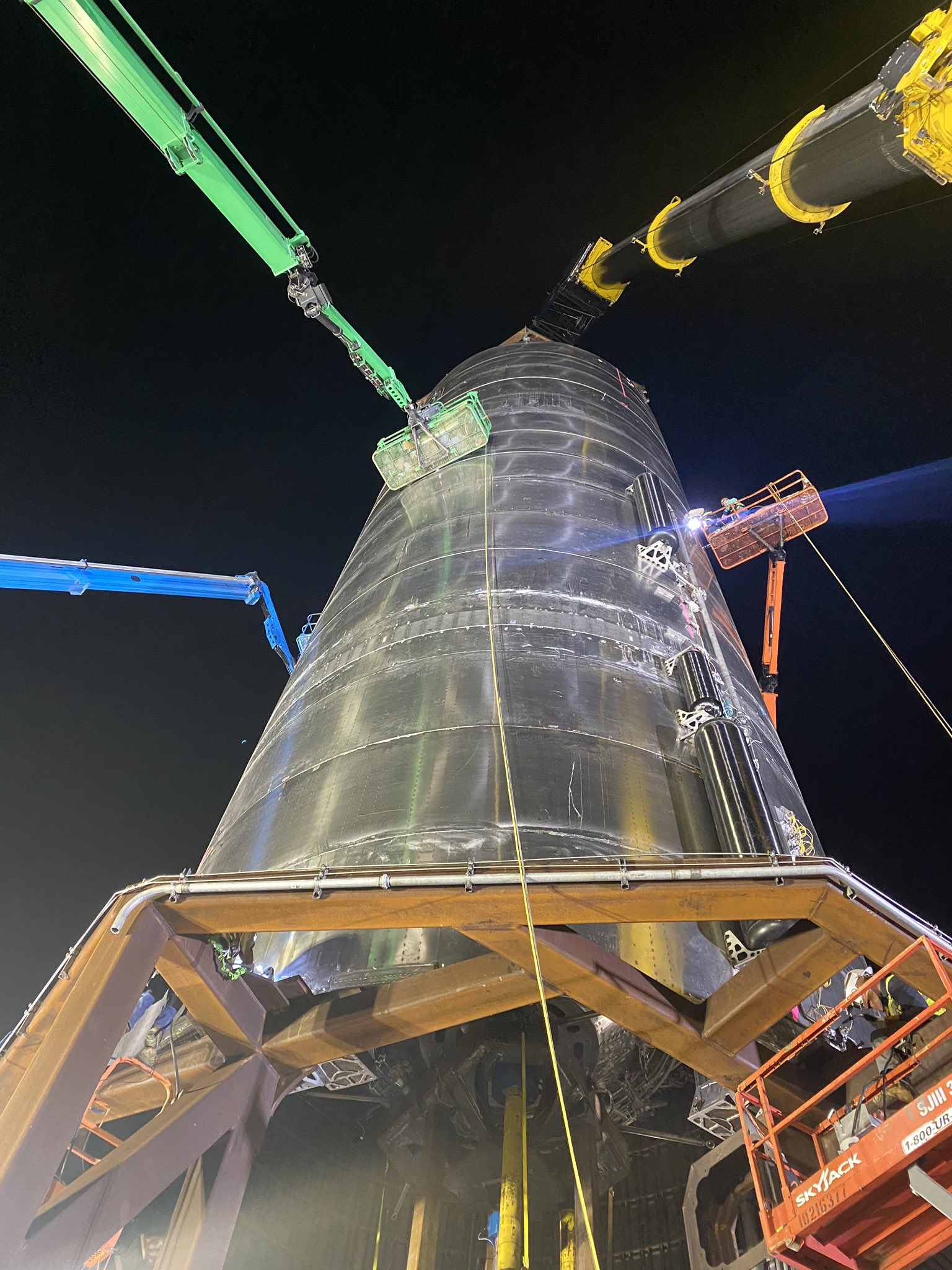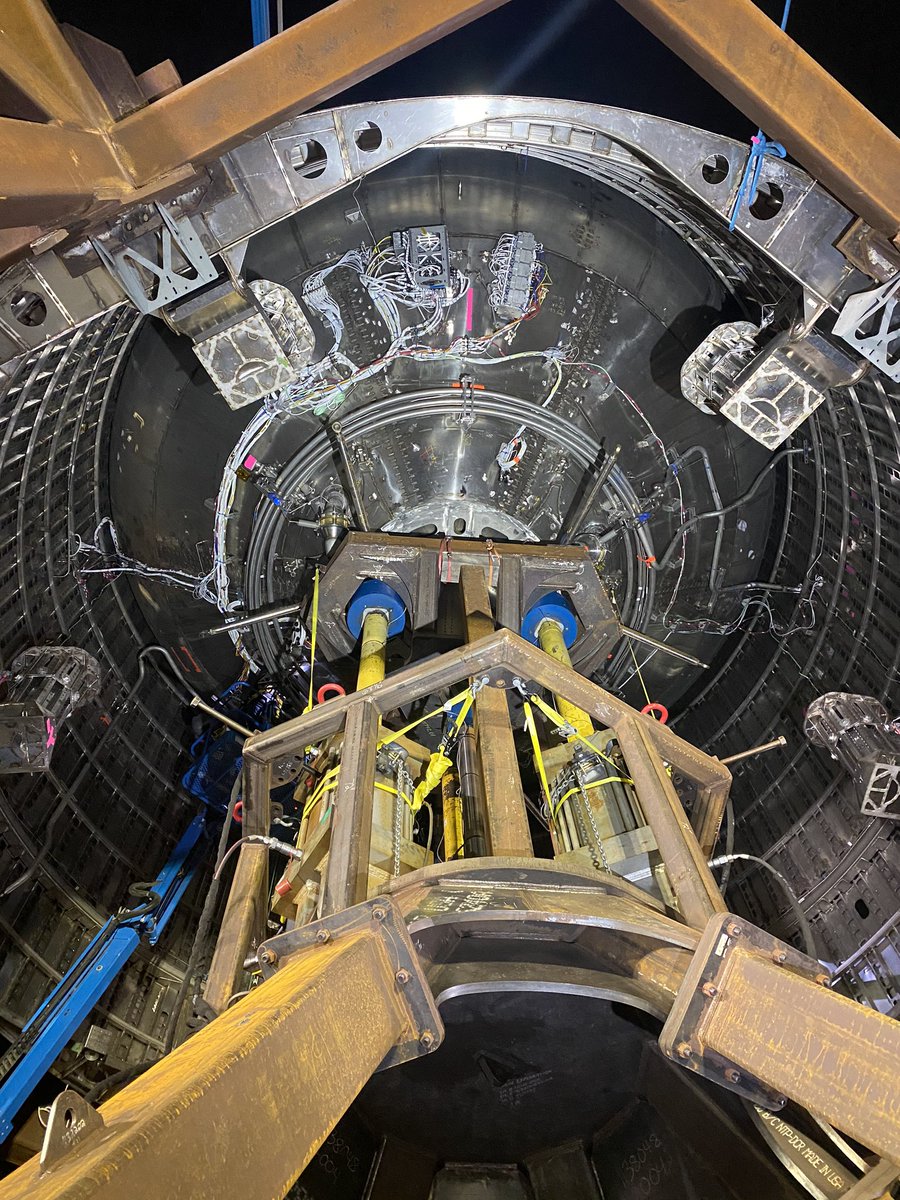Welcome to Tesla Motors Club
Discuss Tesla's Model S, Model 3, Model X, Model Y, Cybertruck, Roadster and More.
Register
Install the app
How to install the app on iOS
You can install our site as a web app on your iOS device by utilizing the Add to Home Screen feature in Safari. Please see this thread for more details on this.
Note: This feature may not be available in some browsers.
-
Want to remove ads? Register an account and login to see fewer ads, and become a Supporting Member to remove almost all ads.
You are using an out of date browser. It may not display this or other websites correctly.
You should upgrade or use an alternative browser.
You should upgrade or use an alternative browser.
In your first photo, looking up the side of the vehicle, on the right side, what are the multiple small cylinders for?
From Elon's twitter feed, SN3 is now on the launch pad for pressure testing, etc.

If it’s made of steel, not much.
"We will see what data review says in the morning, but this may have been a test configuration mistake"
Well that was interesting; the tank initially sort of crumpled in the mid-section and then slumped over when a jet of gas spurted out the right side (as defined by the camera view).
it didn’t appear to explode along a seam. But of course that camera view only showed one side of the vehicle.
it didn’t appear to explode along a seam. But of course that camera view only showed one side of the vehicle.
Well that was interesting; the tank initially sort of crumpled in the mid-section and then slumped over when a jet of gas spurted out the right side (as defined by the camera view).
it didn’t appear to explode along a seam. But of course that camera view only showed one side of the vehicle.
The top skin was frosted, showing it had LN2. The bottom section was shiny, showing it had only gas. If the bottom part depressurized too much, then it would lose structural integrity. I think the big jet was pressure relief due to the tank being partly crushed.
Referring back to @favo's post #634 and its linked photo - Falcon Super Heavy/Starship - General Development Discussion
and my experience in using a crane outside to hoist something inside -
can someone remind me (unless these data are known only from KSC's building) how tall the fab room is and how tall the completed assembly of SN3, for example, is supposed to be? Crane and its operator need quite a fair amount of headroom in order to maneuver, as this picture nicely shows.
and my experience in using a crane outside to hoist something inside -
can someone remind me (unless these data are known only from KSC's building) how tall the fab room is and how tall the completed assembly of SN3, for example, is supposed to be? Crane and its operator need quite a fair amount of headroom in order to maneuver, as this picture nicely shows.
In your first photo, looking up the side of the vehicle, on the right side, what are the multiple small cylinders for?
Those are high pressure tanks, typically used for gaseous pressurant (like Helium).
I don't follow this too much so this is just speculation, but the upper one is probably for the ox tank and the lower one(s?) are for the fuel tank. Curious that there's two lower ones--maybe one is for some function on the motors?
No doubt they're on the outside right now just to make it easier to build/test/fix this prototype; certainly in the future they'll be tucked inside somewhere.
e-FTW
New electron smell
Great view of the structure that they use to simulate thrust to the thrust puck while testing without engines.From Elon's twitter feed, SN3 is now on the launch pad for pressure testing, etc. Maybe a hop if all goes well?


But also: she’s got legs!
Simulation: Kimi Talvitie on Twitter
Elon Musk said:Yes, v close! Nice work. Those are V0.9 legs, so major upgrades coming. Need wider span, longer stroke & ability to auto-level for uneven ground or leaning into high winds.
On to SN4!
Last edited:
e-FTW
New electron smell
JohnSnowNW
Active Member
I wish SpaceX would go with a more conventional rocket to send mass into LEO. They have a good engine (Raptor) and reusable first stage. Spend their time and expertise on innovative in-space components instead.
Falcon and Heavy are the more conventional rockets, and are still successfully flying.
I absolutely love that SpaceX is bucking convention with Starship, and if they can succeed it will completely revamp the space industry. That's pretty amazing, IMHO.
Disagree. Achieving 100% reusability is the essential first step required to lower the cost of access to space enough to enable the exploration and settling of the solar system. We will never see a permanent human presence on Mars without 100% reusability, much less a self-sustaining colony on Mars or even the Moon.I wish SpaceX would go with a more conventional rocket to send mass into LEO. They have a good engine (Raptor) and reusable first stage. Spend their time and expertise on innovative in-space components instead.
I meant a large conventional rocket. A single stick of at least FH capability. The problem is that such a rocket doesn't have enough customers to be viable, so SpaceX is trying to make a fully reusable large system, SS/SH, that's cheap enough to be economically viable even when it doesn't carry a full load all the time (full reuse means only fuel and refurb costs).Falcon and Heavy are the more conventional rockets, and are still successfully flying.
I absolutely love that SpaceX is bucking convention with Starship, and if they can succeed it will completely revamp the space industry. That's pretty amazing, IMHO.
I meant a large conventional rocket. A single stick of at least FH capability. The problem is that such a rocket doesn't have enough customers to be viable, so SpaceX is trying to make a fully reusable large system, SS/SH, that's cheap enough to be economically viable even when it doesn't carry a full load all the time (full reuse means only fuel and refurb costs).
So you want a larger reusable first stage that isn't Super Heavy?
And you want SpaceX to work on "innovative in-space components" that aren't Starship or Starlink?
SpaceX has already disrupted the current market with partial reusability. There are plenty of rockets that get stuff into orbit and GEO. That is the current market because there aren't really any rockets that can do anything else. SpaceX will be creating a market for much more if they can pull off full reusability.
I meant a large conventional rocket. A single stick of at least FH capability. The problem is that such a rocket doesn't have enough customers to be viable, so SpaceX is trying to make a fully reusable large system, SS/SH, that's cheap enough to be economically viable even when it doesn't carry a full load all the time (full reuse means only fuel and refurb costs).
Its a bit of a muddy ask you're making--what do you see as the end goal/product and, as @mongo points out, how would your vision be materially different from what SpaceX is currently doing?
SpaceX has clearly proven that reusability reduces price per kg, which is the primary driver in pretty much any launch that's not state-funded, so it stands to reason that your vision would include reusability. Is your concern with the 'distraction' of making the orbital stage re-usable?
A large conventional rocket would be operational years sooner (assuming SS ever becomes operational). I don't have a problem with SS as a research project.Its a bit of a muddy ask you're making--what do you see as the end goal/product and, as @mongo points out, how would your vision be materially different from what SpaceX is currently doing?
Yes, orbiter reuse is my main issue. If manufacturing SS is so inexpensive to manufacture then that would also make expendable upper stages less expensive.SpaceX has clearly proven that reusability reduces price per kg, which is the primary driver in pretty much any launch that's not state-funded, so it stands to reason that your vision would include reusability. Is your concern with the 'distraction' of making the orbital stage re-usable?
Mo City
Active Member
Going against convention is why SpaceX lapped the field. If Starship and Super Heavy work out, they will be 10 laps ahead of everyone else.I wish SpaceX would go with a more conventional rocket to send mass into LEO. They have a good engine (Raptor) and reusable first stage. Spend their time and expertise on innovative in-space components instead.
The innovation, openness and enthusiasm injected into the rocket industry by SpaceX is so refreshing.
A large conventional rocket would be operational years sooner
If manufacturing SS is so inexpensive to manufacture then that would also make expendable upper stages less expensive.
Both pretty fair points.
IMHO the timeline probably wouldn't end up too different. Unlike landing F9 cores there's quite a bit of precedent on atmospheric re-entry, so that technical element of Starship--which is the major difference from a conventional second stage+PLF--its much less an iterative science project and much more evolution of existing technology.
But you've definitely hit on a conundrum with the financial element. Its really hard to get a good idea on how much the thing is actually going to cost, and it doesn't help that in general the SpaceX numbers conflated about the internet are based on Elon's tweets about impossibly inexpensive things that don't factor things like non-recurring and early production development. So then to your point I'd contest that, specifically because SS manufacturing isn't going to be as cheap as implied--and as has been proven on Falcon--SpaceX has determined building fewer, more expensive, reusable Starships is a faster and cheaper path than equivalent expendable things. It makes sense, because at the volumes used in space and especially launchers (vs, like a gazillion reaction wheels for a LEO constellation) its really cost inefficient to set up a highly automated volume production facility. Better to save some of that industrialization Capex/NRE and/or redirect those dollars toward the product.
Have any reentry vehicles had a stainless steel exterior? I guess SpaceX is looking into some sort of standard heat shielding in the hottest areas ... but their plans change so often it's difficult to keep up.Both pretty fair points.
IMHO the timeline probably wouldn't end up too different. Unlike landing F9 cores there's quite a bit of precedent on atmospheric re-entry, so that technical element of Starship--which is the major difference from a conventional second stage+PLF--its much less an iterative science project and much more evolution of existing technology.
I'd say that F9 was successful because it made (basically) one significant change in standard rockets: reusing the first stage. With SS they're significantly changing many items simultaneously: new engine, new construction, new reentry style, new landing style, new exterior material, new aerodynamic features, etc. That's plenty for just a research project, not to mention a development project. Maybe it'll all magically come together in a year.
Similar threads
- Replies
- 2
- Views
- 645
- Article
- Replies
- 203
- Views
- 6K
- Replies
- 667
- Views
- 29K
- Replies
- 93
- Views
- 5K


